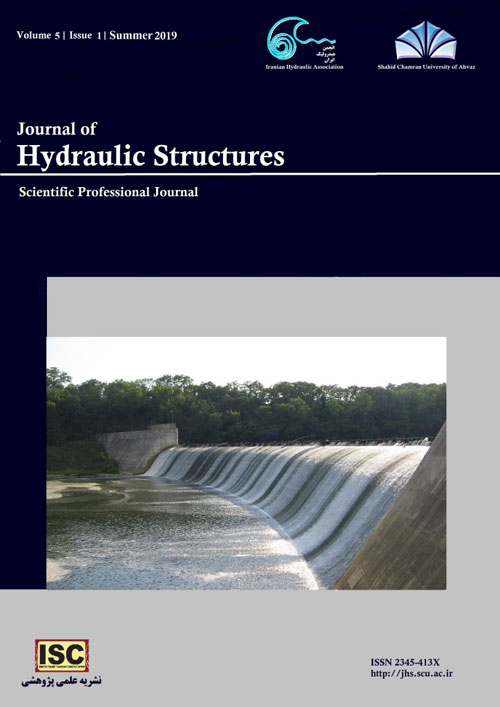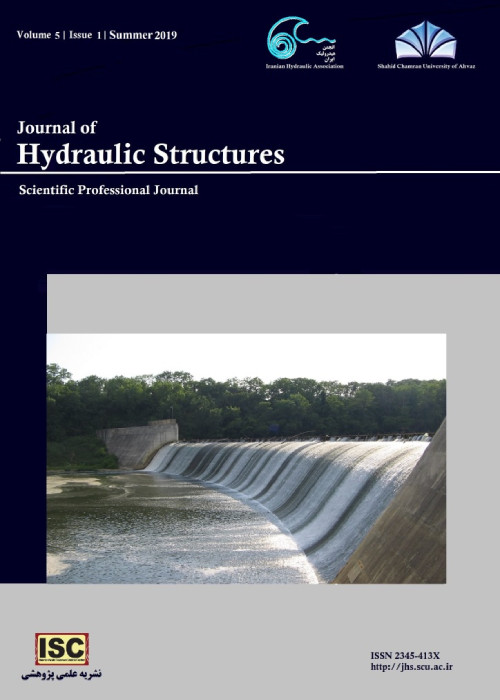فهرست مطالب

Journal of Hydraulic Structures
Volume:7 Issue: 3, Autumn 2021
- تاریخ انتشار: 1400/10/04
- تعداد عناوین: 5
-
-
Pages 1-22
In the present study, an artificial neural network and its combination with wavelet theory are used as the computational tool to predict the depth of local scouring from the bridge pier. The five variables measured are the pier diameter of the bridge, the critical and the average velocities, the average diameter of the bed aggregates, and the flow depth. In this study, the neural wavelet method is used as a preprocessor. The data was passed through the wavelet filter and then passed to the artificial neural network. Among the various wavelet functions used for preprocessing, the dmey function results in the highest correlation coefficient and the lowest RMSE and is more efficient than other functions. In the wavelet-neural network compilation method, the neural network activator function was replaced by different wavelet functions. The results show that the neural network method with the Polywog4 wavelet activator function with a correlation coefficient of 87% is an improvement of 8.75% compared to the normal neural network model. By performing data filtering by wavelet and using the resulting coefficients in the neural network, the resulting correlation coefficient is 82%, only a 2.5% improvement compared to the normal neural network. By analyzing the results obtained from neural network methods, the wavelet-neural network predicted errors compared to experimental observations were 8.26, 1.56, and 1.24%, respectively. According to the evaluation criteria, combination of the best effective hydraulic parameters, the combination of wavelet function and neural network, and the number of neural network neurons achieved the best results.
Keywords: Artificial neural network, Bridge Cylindrical Pier, Scour depth, Wavelet Theory -
Pages 23-32The stability of soil slopes and the determination of safety factors have always been the subject of study for engineers and researchers. The safety factor of slopes can be determined by using the methods of limit equilibrium method (L.E.M.), limit analysis, and strength reduction method (S.R.M.). The equilibrium method determines the slope safety factor based on the equilibrium of the inter-slice force and without the analysis of tension and strain. In the strength reduction method, based on the tension-strain analysis, the strength of various points of the slope is reduced until it reaches the critical state, and by connecting all of the critical points, the critical rupture level will be obtained. Finite element software and finite difference software determine the safety factors in soil slopes by using the concepts of the strength reduction method. In this paper, the safety factors of soil slopes are determined by using ABAQUS software, and using the concept of strength reduction method. There is no option in ABAQUS for the determination of safety factors and it should be obtained by defining the concepts of strength reduction. The purpose of this study is to implement a strength reduction method in a finite element program to calculate the safety factor of slopes. The results of this research indicate that the changes in friction angle affect the safety factor changes more than variations in cohesion. Also, slope angle and its changes affect the safety factor changes more than other factors.Keywords: Factor of Safety, Slope stability, ABAQUS, Sensitive analysis
-
Pages 33-41Discharges in hydrometric stations are estimated by converting the stage values to the discharge using a stage-discharge relationship or by multiplying mean velocity with flow cross-sectional area. Estimation of mean velocity in hydrometric stations, especially during flood events, is not easily possible. Therefore, the method of estimating mean velocity by converting the maximum velocity to mean velocity using a conversion factor is a desirable method. The velocity convert factor estimation in stations without enough valuable measured discharge data is a challenging issue. Present study develops a method for determining the conversion factor by combining the entropy velocity profile and a data-driven technique (genetic programming) by knowing only one mean velocity value, and thus develops a method to determine discharge at the weak gauging sites. The advantage of the method introduced in this study is the simplicity of application and the use of parameters that can be easily measured to estimate the mean velocity values. The performance of the method was evaluated by comparing the computed and the observed mean velocity values and the Root Mean Square Error and the Mean Absolute Error were found to be 0.05 m s-1 and 0.04 m s-1, respectively. The results showed that the introduced method estimates a suitable conversion factor compared to similar methods and is applicable for stations without measurement.Keywords: Water Width to Water Depth Ratio, Data-Driven Technique, Entropy Velocity Profile, Stage-Discharge, Mean velocity
-
Pages 42-58Side weirs are one of the most common water structures that are used to transfer or pass flood and excess water from headwater to downstream in channels and dams. One of the factors, which is often less considered in the design of such weirs, is the amount of suspended load along with the flow. Basically, suspended sediments along with the flow, in addition to changes in the density of the passing water, can change most of the assumptions in the design of weirs. Due to the high cost and time-consuming nature of physical modeling, the powerful Flow-3D numerical model was used to simulate the flow of suspended sediments in this study. A channel with a side weir was modeled according to laboratory conditions and the discharge coefficient passing through the side weir at different concentrations of the suspended load was calculated. The results, while confirming the ability of the Flow-3D numerical model to simulate the flow containing sediment passing through the side weirs, showed that with increasing the concentration of suspended flow load, the discharge coefficient passing through the side weir increases. Also, increasing the weir’s height along with increasing the concentration of suspended sediments has led to a significant increase in the discharge coefficient passing through the side weir.Keywords: Side weir, Suspended sediments, Discharge Coefficient, Flow-3D numerical model
-
Pages 59-71Bridges are one of the most important and widely used river structures. Every year, a large number of them are destroyed by factors such as scouring and erosion. It is sometimes observed that the bridges are placed in the river bend, due to restrictions such as the road construction or river instability. On the other hand, studies have shown that the geometric shape of the bridge pier will have significant effect on the depletion of flow energy and thus reduce the scour depth around the bridge pier. Therefore, in this study, the effect of bend angle changes on flow pattern and local scouring around the of cylindrical bridge piers with aerodynamic shapes were investigated. SSIIM Three-dimensional software was used for modeling. The results showed that by increasing the bend angle and also placing the pier with a wide nose upstream, the amount of depth and volume of scouring increases, so that, the maximum depth and volume of scour occurred at a 90-degree angle to 0.1197123m and 0.08436892m3, respectively.Keywords: Bend angle, Local Scouring, Bridge pier, Aerodynamic shape, SSIIM numerical model


